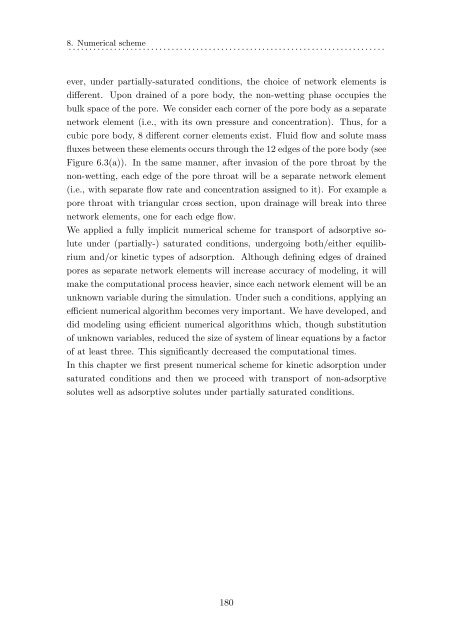download pdf version of PhD book - Universiteit Utrecht
download pdf version of PhD book - Universiteit Utrecht
download pdf version of PhD book - Universiteit Utrecht
Create successful ePaper yourself
Turn your PDF publications into a flip-book with our unique Google optimized e-Paper software.
8. Numerical scheme<br />
. . . . . . . . . . . . . . . . . . . . . . . . . . . . . . . . . . . . . . . . . . . . . . . . . . . . . . . . . . . . . . . . . . . . . . . . . . . . .<br />
ever, under partially-saturated conditions, the choice <strong>of</strong> network elements is<br />
different. Upon drained <strong>of</strong> a pore body, the non-wetting phase occupies the<br />
bulk space <strong>of</strong> the pore. We consider each corner <strong>of</strong> the pore body as a separate<br />
network element (i.e., with its own pressure and concentration). Thus, for a<br />
cubic pore body, 8 different corner elements exist. Fluid flow and solute mass<br />
fluxes between these elements occurs through the 12 edges <strong>of</strong> the pore body (see<br />
Figure 6.3(a)). In the same manner, after invasion <strong>of</strong> the pore throat by the<br />
non-wetting, each edge <strong>of</strong> the pore throat will be a separate network element<br />
(i.e., with separate flow rate and concentration assigned to it). For example a<br />
pore throat with triangular cross section, upon drainage will break into three<br />
network elements, one for each edge flow.<br />
We applied a fully implicit numerical scheme for transport <strong>of</strong> adsorptive solute<br />
under (partially-) saturated conditions, undergoing both/either equilibrium<br />
and/or kinetic types <strong>of</strong> adsorption. Although defining edges <strong>of</strong> drained<br />
pores as separate network elements will increase accuracy <strong>of</strong> modeling, it will<br />
make the computational process heavier, since each network element will be an<br />
unknown variable during the simulation. Under such a conditions, applying an<br />
efficient numerical algorithm becomes very important. We have developed, and<br />
did modeling using efficient numerical algorithms which, though substitution<br />
<strong>of</strong> unknown variables, reduced the size <strong>of</strong> system <strong>of</strong> linear equations by a factor<br />
<strong>of</strong> at least three. This significantly decreased the computational times.<br />
In this chapter we first present numerical scheme for kinetic adsorption under<br />
saturated conditions and then we proceed with transport <strong>of</strong> non-adsorptive<br />
solutes well as adsorptive solutes under partially saturated conditions.<br />
180

















